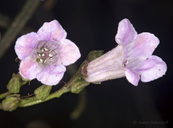Taxon Report
Eriodictyon altissimum WellsIndian Knob mountainbalm |
 Aaron Schusteff |
Taxon Summary
Eriodictyon altissimum, commonly known as Indian Knob mountainbalm, is a perennial evergreen shrub in the Namaceae that is found only in California. It occurs within Chaparral (maritime), Cismontane woodland, and Coastal scrub, growing at elevations from 80 to 270 meters. Eriodictyon altissimum is ranked 1B.1, Plants Rare, Threatened or Endangered in California and Elsewhere; Seriously threatened in California.Classification
|
Scientific Name: |
Eriodictyon altissimum Wells |
|
Common Name: |
Indian Knob mountainbalm |
| Family: | Namaceae |
| Element Code: | PDHYD04010 |
| USDA Plants Symbol: | ERAL12 |
|
Synonyms/Other Names: |
|
Ecology and Life History
| Lifeform: | perennial evergreen shrub |
| Blooming Period: Mar-Jun | Mar-Jun |
| Elevation: | 80-270 (260-885) |
| General Habitats: | Chaparral, Cismontane woodland, Coastal scrub |
| Microhabitat: | Sandstone |
| Microhabitat Details: |
Conservation Status
| CA Rare Plant Rank: | 1B.1 |
| Global Rank: | G1 |
|
State Rank: |
S1 |
| State List: | CE |
| Fed List: | FE |
| Other Status: | SB_CalBG/RSABG; SB_USDA |
|
CRPR Changes: |
|
Occurrence Data from the CNDDB
| Total Occurrences: | 6 |
| Element Occurrence Ranks: | |
| Excellent (A) | 1 |
| Good (B) | 1 |
| Fair (C) | 2 |
| Poor (D) | 0 |
| None (X) | 1 |
| Unknown (U) | 1 |
| California Endemic: True | |
| California Counties and Islands: Name (Code) | |
| San Luis Obispo (SLO) | |
| Quads: Name (Quad Code) | |
| Morro Bay South (3512037), Pismo Beach (3512026) | |
Threat List Data from the CNDDB
| Threat List Total: | 8 | |
| EOs with Threat Listed: | Total EOs | % of EOs |
| 5 | 83 % | |
| Other | 2 | 33% |
| Recreational use (non-ORV) | 2 | 33% |
| Road/trail construction/maint. | 1 | 16% |
| Wood cutting or brush clearing | 1 | 16% |
| Development | 1 | 16% |
| Erosion/runoff | 1 | 16% |
| Foot traffic/trampling | 1 | 16% |
| Improper burning regime | 1 | 16% |
Citation
California Native Plant Society, Rare Plant Program. 2025. Rare Plant Inventory (online edition, v9.5.1). Website https://www.rareplants.cnps.org [accessed 28 December 2025].